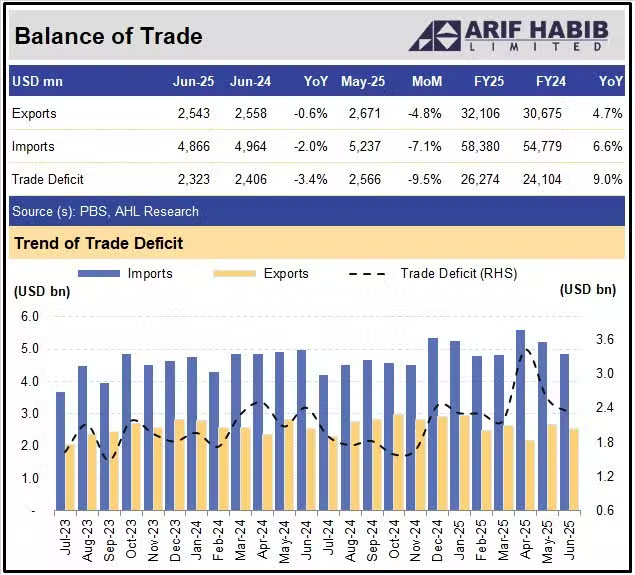In a year marked by rising global prices and ongoing economic challenges, Pakistan’s trade deficit has widened significantly — reaching $26.27 billion in the fiscal year 2024–25 (FY25), up 9% from $24.10 billion recorded in FY24, according to fresh figures released by the Pakistan Bureau of Statistics (PBS).
This growing trade gap is ringing alarm bells for policymakers, economists, and businesses alike. But what’s really behind this concerning surge?
🔍Pakistan’s Trade Exports Rise Slightly, But Can’t Keep Up
Pakistan’s exports climbed 4.7%, hitting $32 billion in FY25 — a modest increase from $30.67 billion in FY24. Despite efforts to boost local production and tap into international markets, the growth in exports remains slow compared to the rising import bill.
Experts believe the limited diversification of export items, lack of value addition, and energy supply issues in the manufacturing sector are key reasons why export momentum hasn’t matched expectations.

📦 Imports Jump 6.6% — Why the Spike?
On the flip side, imports grew by 6.6%, reaching $58.38 billion in FY25 versus $54.78 billion the year before. A major portion of this surge is attributed to:
- High global oil prices
- Machinery and raw material imports to support industrial activity
- Increased reliance on imported food items due to domestic shortages
This imbalance — more dollars flowing out than in — continues to pressure Pakistan’s foreign exchange reserves, keeping the rupee under stress.
Read More: 5 Everyday Habits That Silently Damage Your Brain – Most People…
📉 June Snapshot: Month Ends on a Sluggish Note
Looking at the month of June 2025, the trade activity saw a dip:
- Exports stood at $2.54 billion, down 0.6% YoY and 4.8% MoM
- Imports hit $4.86 billion, down 2% YoY and 7.1% MoM
- The monthly trade deficit landed at $2.56 billion
This month-on-month decline could signal seasonal drops, but some analysts warn it might be an early sign of slowing global demand and domestic production fatigue.
📊 The Broader Picture: What It Means for Pakistan
A widening trade deficit like this can have far-reaching consequences:
- 📉 Weakened Currency: Demand for dollars increases, which can devalue the Pakistani rupee
- 📈 Inflation: Expensive imports add to the rising cost of living
- 💸 Debt Pressure: More borrowing needed to finance the gap, leading to higher interest payments
- 🏦 Policy Tightening: Government may introduce stricter import controls or increase duties
🧠 Expert Insight: What Needs to Change?
According to economists, Pakistan’s way out is not just through import controls, but through strategic economic reforms:
- Boost export competitiveness with tech and infrastructure upgrades
- Encourage local production and reduce import dependency
- Diversify export markets beyond traditional partners
- Invest in skills development to support high-value industries
✅ Final Word
While a $26 billion trade deficit is indeed a wake-up call, it’s not the end of the road. With focused reforms and long-term planning, Pakistan can narrow the gap and build a more sustainable trade model.
For now, however, the growing imbalance reflects the urgent need for economic discipline, export innovation, and a united national focus on self-reliance and global competitiveness.

I’m M. Ali Sher, founder of Aft4all, a platform where I share updates and insights across 📂 categories like 📰 News & Media, 🚗 Car Dealership, 🎤 Motivational Speaking, and 🚲 Bike Parking Solutions. My goal is to inform, inspire, and offer practical content for everyone.







